There’s something unwittingly abstract about our interactions with virtual worlds, yet our language implies a kind of physicality: we move from page to page, we follow links, we send mail, we visit sites. The structure of the internet and the way in which we interact with it has come to change the way we think. The virtual space in which we move about disembodies the arbitrary linearity of language. Through the use of the book, language, and thus thought, were linear. Now, however, language and thought no longer move in this linear fashion: hyperlinks have become commonplace, if not expected, communicating information in many dimensions at once. This method of transferring information in language has forced thought to alter its structure. But there is something unsettling about the erratic nature of hyperlinks. Because of their immateriality, hyperlinks distract one’s ability to sift through and be confronted by the priorities of text. The structure of one’s thought crumbles, and one is left with a mass of information without any methodology or teleological aim. There thus remains in thought only a mechanistic moving about from one subject to the next, without any solid connections. There is little or no continuity, only abstract constructions through which one passes.
How does one put into words the significance of physicality? Namely, the significance of being grounded to the ground, of perceptual and sensuous experience, without which we are paralysed with anxiety. There comes an attachment to the words, their meanings and significance when they are written on a page as opposed to when they are merely floating in virtual space. Language falls apart once confronted with its own inadequacies in translating the physical to the abstract. Thus every philosopher comes to a moment at which she must establish a relationship between the structures of thought and experience that forge a continuity between thought and experience. Every theory of semantics comes to the point at which it must decide which structure imposes itself on the other: experience on language, or language on experience. At a basic level, it is experience that imposes itself upon language, but after the elementary stages of the learning of language have passed, language imposes itself on one’s interpretations of experience in thought. In this way, although experience is the source of what can be known, it is the structure of language that is the media through which one experiences the world, or takes in information about the world, and determines what is this known.
My aim in this project is to examine the relationship between snippets of information that add to the whole of a linear narrative, and the structure in which this information operates. The physicality of the hypertext makes one’s interaction with it awkward and frustrating, yet grounding. The “links,” which are made of embroidery thread (each link with its own colour to ease the process), become inevitably entangled. And the flipping through the hyperlinked texts becomes almost frustratingly time-consuming. However, one has a consistent sense of calm: the original text is there in your hands; the entire stack of linked texts are at your disposal, in your control. One’s thoughts do not become erratic, forgetting where one began, or if there was any goal in beginning the task of reading the text. It is a tangible construction with which one can interact.
I wanted to extend the sense of physicality to that of the type-written linked texts. In using word processors on computers, one is used to the constant deletion of mistakes. In using a type-writer, however, one must either discard one’s work completely and begin anew, or ‘x’ the mistakes out. The text is thus littered with x’s and coffee stains that reaffirm its physicality.
The text itself is an examination of a fictional text: a story about a possible world in which the city develops consciousness and rationality. The city in this non-pre-existing text is viewed through Leibnizean hermeneutics. Each item of text, that is, the hyperlinks and the main text, addresses the problem of physicality and abstraction, displaying the absurdity of the hypertext as a medium: the movement through abstract space and the immateriality of physicality. Although, it is not directly communicating these ideas: it presents the audience with an experience. An experience that can only be felt.




